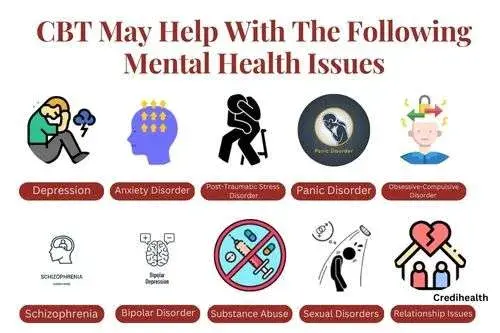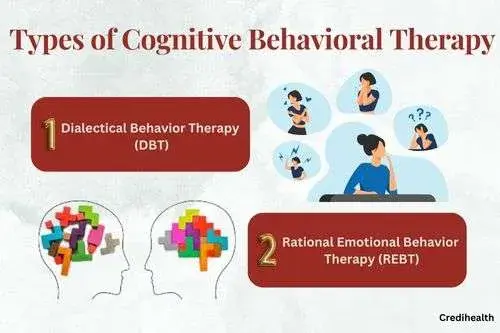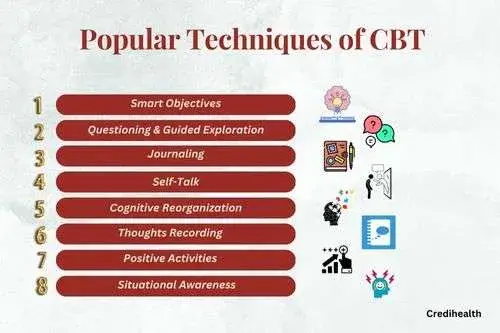Cognitive behavioral therapy (CBT) is a goal-oriented, structured talk therapy. It can assist with mental health illnesses, including depression, anxiety, and emotional issues like loss and stress. Non-psychological health issues, such as sleeplessness and chronic pain, can also benefit from CBT. In this blog post, we'll explore what CBT is, how it works, and the different techniques and strategies that are used in this type of therapy. Whether you're considering CBT for yourself or someone you know, or you're just curious about this approach to therapy, this post will give you a better understanding of What is cognitive behavioral therapy? And how it can help.
What is cognitive behavioral therapy (CBT)?
Cognitive behavioral therapy (CBT) is a therapeutic method that assists you in identifying negative or unhelpful thought and behavior patterns. CBT seeks to assist you in identifying and exploring how your emotions and ideas influence your behavior. Once you've identified these patterns, you may work on changing your behavior and developing new coping mechanisms. Other types of psychotherapy are equally or even more beneficial for some illnesses in some people.
Also Read: Psychiatrists Vs. Psychologists - What Is the Difference?
What principle underlies cognitive behavioral therapy?
CBT is based on the principle that thoughts, feelings, and behaviors are all connected and influence each other. CBT aims to identify and change dysfunctional thoughts, emotions, and behaviors by focusing on the present rather than the past, to improve mental health.
What can cognitive behavioral therapy do for you?
CBT is an effective method for dealing with emotional issues. For example, it might assist you with the following:
- Handle the symptoms associated with mental illness.
- Avoid a recurrence of mental disease symptoms.
- When drugs aren't an option, treat the mental disease.
- Discover how to deal with tough life events.
- Determine how to deal with your emotions.
- Overcome interpersonal difficulties and improve your communication skills.
- Deal with sadness or loss.
- Overcoming emotional pain caused by abuse or violence.
- Handle a medical condition.
- Control chronic physical symptoms.
However, you need not suffer from a specific mental health issue to benefit from CBT.
It can also assist with the following

CBT may help with the following mental health issues:
- Depression
- Anxiety disorder
- Post-traumatic stress disorder (PTSD)
- Panic disorder and phobia
- Obsessive-Compulsive Disorder (OCD)
- Schizophrenia.
- Bipolar disorder
- Substance Abuse
- Sexual disorders
- Relationship issues, Divorce or breakup
Also Read: An Ultimate Guide to Sexual Health Basics
What are the types of Cognitive Behavioral Therapy?

CBT includes a variety of strategies and approaches for dealing with our thoughts, emotions, and actions. Structured psychotherapies and self-help activities are examples of this. Cognitive behavioral therapy is used in a variety of treatment techniques, including: Cognitive therapy focuses on recognizing and altering distorted or incorrect cognitive processes, emotional responses, and behaviors.
1. Dialectical Behavior Therapy (DBT)
Focuses on damaging or distressing ideas and actions while using therapy tactics such as emotional control and mindfulness. According to multimodal therapy, psychological concerns must be addressed through seven distinct but interrelated modalities: behavior, affect, sensation, imagery, cognition, interpersonal variables, and drug/biological considerations.
2. Rational Emotional Behavior Therapy (REBT)
Detecting irrational ideas, actively questioning these beliefs, and learning to recognize and challenge their challenge.
Also Read:What you should know about your Mental Health after menopause
What are the techniques of Cognitive Behaviour therapy?
CBT employs a wide range of approaches. The therapist will collaborate with you to identify the ideal ones. Standard therapy includes the following:
- Seeing how wrong thinking may exacerbate difficulties.
- Acquiring new problem-solving abilities.
- Acquiring confidence and a greater knowledge and respect of own self-worth.
- Learning how to tackle anxieties and problems.
- When confronted with potentially difficult situations, use role play and relaxing strategies.
- These strategies aim to replace negative or self-defeating ideas with more positive and realistic ones.
Some popular techniques include,

1. Smart objectives - Smart goals are specific, measurable, realistic, achievable, and time-limited.
2. Questioning and guided exploration - A therapist may encourage you to examine these views and seek alternative perspectives by challenging the assumptions regarding yourself or the present circumstances.
3. Journaling - You may be asked to write down negative thoughts that arise over the week and good beliefs that may be exchanged for them.
4. Self-talk - Your therapist may inquire about what you tell yourself about a particular event or experience and then urge you to replace unpleasant or critical self-talk with loving, constructive self-talk.
5. Cognitive reorganization - It entails identifying and unraveling any cognitive distortions impacting your ideas, such as black-and-white thinking, leaping to conclusions, or overthinking things.
6. Thoughts recording - In this method, you'll record your unrealistic thoughts and feelings throughout a given circumstance, then come up with real facts supporting and refuting your negative belief. This evidence will be used to construct a more realistic thought.
7. Positive activities - Including a gratifying activity in your daily routine will assist in boosting your overall happiness and enhance your mood. Buying things like flowers and fruits and watching your favorite movies and shows and dates make your mind free.
8. Situational awareness - This entails cataloging circumstances that generate discomfort in order of severity and gradually exposing oneself to these things until they create less unpleasant sensations. A related method is a systematic desensitization, in which you will learn relaxing techniques for coping with feelings in hard situations.
Also Read: Inpatient Mental Health Treatment: 7 Things To Expect
What are the benefits of cognitive behavior therapy?
There are benefits to participating in any treatment - not only for you but your family members, spouse, or other individuals. The primary advantages of CBT.
- The total course of treatment is shorter. The therapy duration is often shorter than other therapies, ranging from 5 to 20 sessions.
- CBT produces long-term benefits. According to depression research, those who have received CBT are less prone to relapse than those who have taken antidepressant medicines with no CBT.
- Sessions are customizable and can take a variety of forms. One can attend in-person training that is either individual or group. Many people even receive CBT over the phone or online.
- Therapy skills may be transferred directly to daily life. The purpose of CBT is to provide the individual undergoing therapy with skills. These strategies assist patients in gaining control of their challenges during and after therapy.
- Those who get CBT may find it empowering to participate actively in rehabilitation. People in therapy eventually want to conquer challenges independently, utilizing the skills they learned in sessions.
Also Read: Effects of Social Isolation on Mental Health
What are the things to consider before cognitive behavior therapy?
CBT can be beneficial. Though, if you decide to try it, there are a few things to consider.
1. It is not a cure
Counseling can help alleviate the issues, but it cannot erase them. Even after counseling, mental health difficulties and emotional suffering may continue. The purpose of CBT is to assist you in building the skills you need to cope with problems by yourself when they arise. Some people see the technique as training for them to give their therapies.
Also Read: Understanding The Differences Between Counseling And Therapy
2. It takes time to see results
CBT might span weeks or months, with one session per week. You and the therapist will most likely discuss how long treatment will last during your initial few sessions. But, it will require time before you notice any cbt benefits. You may be concerned that therapy is still not working if you don't feel much better within a few sessions, but take your time. Continue to do the homework and practice your skills between sessions. Be gentle with yourself.
Also Read: What is Anorexia Nervosa?
3. It will be Challenging
Counseling may be very emotional. It frequently aids in your improvement over time, but the approach might be difficult to talk about things that are hurtful or disturbing to you. Don't be concerned if you cry during a session; this is common in therapy.
4. It's simply one of many options
Though CBT can benefit many people, it is not right for everyone. Do not get disheartened if you do not notice any improvements after a few sessions. Consult with your therapist. A good therapist can assist you in recognizing when one strategy is ineffective. They may offer alternative ways that are more beneficial.
You can also read Mental Health And Wellness: Psychologist Guide
Conclusion
CBT may be an excellent therapy option if you seek something that focuses on the current difficulties rather than ones from the past. It is a short-term therapy that demands you to participate actively. Talking with a therapist will assist you in setting your therapy goals and determining whether CBT or its variants are the best options for you. If CBT isn't right for you, alternative treatment methods could be a better match. With the help of a skilled cognitive behavioral therapy therapist, you can learn to identify and challenge negative patterns of thinking and behavior and start making positive changes in your life.
Also Read:What are the 12 most Common Phobias?
Frequently Asked Questions
What is cognitive behavioral therapy and how does it work?
Cognitive behavioral therapy is a short-term therapy that focuses on changing negative thought patterns and behaviors to improve coping and functionality.
What is an example of cognitive behavioral therapy?
An example of CBT would be working to change irrational fears about social situations by gradually increasing exposure combined with changing thoughts.
What are the 5 steps of CBT?
The 5 steps of CBT are assessing the problem, becoming aware of thoughts and feelings, identifying distorted thinking, behavior change strategies, and preventing relapse.
What are the 5 components of cognitive behavioral therapy?
The 5 components of CBT are the relationship between therapist and client, identifying troubling situations, identifying thoughts, emotions and beliefs, pinpointing harmful patterns, and changing cognitive distortions and behaviors.
What are the 3 C's of cognitive therapy?
The 3 C's of cognitive therapy are catch it, check it, and change it - catch automatic negative thoughts and cognitive distortions, check if they are inaccurate or irrational, and change them to be more balanced and realistic.
What are the types of behavior therapy?
Types of behavior therapy include classical conditioning, operant conditioning, modeling, token economy, contingency management, exposure therapy, cognitive behavioral therapy (CBT), and acceptance and commitment therapy (ACT).
Difference between group therapy and behaviour therapy
Group therapy employs group interactions as the means of creating change, whereas behavior therapy directly applies techniques to change behaviors.

Reviewed by







